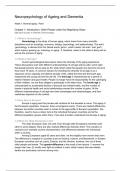Summary
Summary Neuropsychology of ageing and dementia (book chapters + articles) RUG
- Course
- Institution
- Book
An extensive summary of the required literature for the course neuropsychology of ageing and dementia from the RUG. It includes the required Chapters 2, 12, 28, 29, 30, 31, 33, 34 from the book: Handbook on the Neuropsychology of Aging and Dementia (2nd edition). In addition, the few required c...
[Show more]



